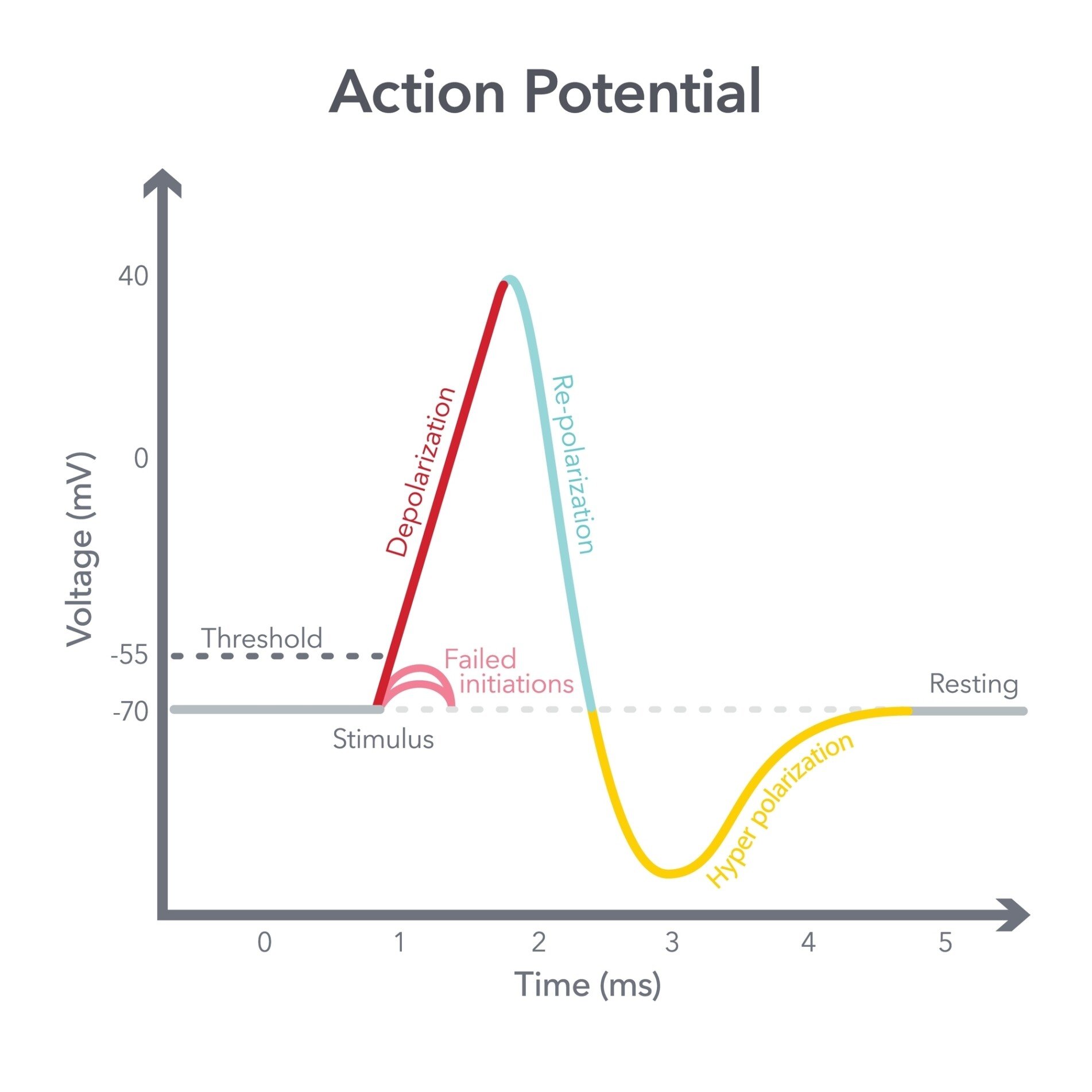An action potential is an electrical nerve impulse that travels along a neuron’s axon. It’s a transient, all-or-nothing electrical current that is conducted down the axon when the neuron’s membrane potential reaches a specific “threshold of excitation.”
You can think of an action potential like a nerve message or an electrical signal. It behaves much like pulling the trigger of a gun: a neuron either fires completely or it doesn’t fire at all – there’s no in-between stage, just as pulling harder on a gun trigger doesn’t make the bullet travel faster.
Similarly, once an action potential starts, it’s like sending an email or text message; you can’t stop it once it’s initiated.
The signal moves down the axon like a flame moving along a fuse or a wave, regenerating at full strength and not fading away.

Why are action potentials important?
Action potentials are fundamental electrical impulses crucial for all nerve functions and the nervous system’s ability to process and transmit information.
They enable neurons to communicate by acting as the electrical signal that travels down an axon.
When this impulse reaches the axon terminal, it triggers the release of chemical neurotransmitters into the synapse, transmitting the message to adjacent neurons.
This electrochemical communication is the basis for all nerve functions, allowing processes like thought, memory, and emotion.
Action potentials are vital for muscle contraction, as motor neurons carry these impulses from the central nervous system to muscles, enabling voluntary movement.
They are critical for brain signaling, forming the rapid electrical basis of sensory detection (e.g., light, touch) and the perception of sensations like pain.
In reflexes, action potentials allow for immediate, involuntary responses, like withdrawing a hand from a hot object, without direct brain input, saving crucial seconds for survival.
Overall, they are essential for coordinated bodily control and interaction with the environment.
Where do action potentials occur?
Action potentials are typically generated in a neuron’s axon hillock, the specialized region where the axon extends from the cell body, once the “threshold of excitation” is reached.
From there, this “all-or-none” electrical signal rapidly travels down the entire length of the axon to the axon terminals (or terminal buttons) at its end.
Beyond neurons, action potentials are fundamental to other excitable cells.
For instance, motor neurons use action potentials to transmit commands from the nervous system to muscle fibers, initiating muscle contraction.
Similarly, sensory neurons convert external stimuli into action potentials to relay information about touch, sight, hearing, and pain to the central nervous system.
What causes an action potential to fire?
An action potential fires when a neuron receives sufficient stimulation, typically from neurotransmitters binding to its dendrites.
This stimulus causes small pores or voltage-gated channels on the neuronal membrane to open, allowing positively charged sodium (Na+) ions to rush into the cell.
This influx of positive ions depolarizes the cell, making its internal charge more positive.
If this charge reaches a specific threshold of excitation, typically around -55mV, the neuron becomes active and an action potential begins.
This event operates on the all-or-nothing principle: it either fires completely at its full strength or not at all; there is no partial firing.
Immediately after the peak depolarization, sodium gates close, and voltage-gated potassium (K+) channels open, allowing K+ ions to exit, quickly repolarizing the cell.
The 3 phases of an action potential
The transmission of a nerve impulse, known as an action potential, involves a rapid sequence of electrical changes across the neuron’s membrane.
This dynamic process typically proceeds through three distinct phases:
Depolarization (Rising Phase)
A neuron at resting potential maintains a negative charge inside, usually around -70mV, with higher sodium (Na+) ion concentrations outside and potassium (K+) ions inside.
When sufficiently stimulated, voltage-gated sodium (Na+) channels open, allowing positively charged Na+ ions to rapidly rush into the cell. This influx causes the inside of the cell to become more positive.
If this charge reaches the threshold of excitation (around -55mV), a massive influx of Na+ occurs, creating a positive spike in the membrane potential. This operates on an all-or-nothing principle.
Repolarization (Falling Phase)
Immediately following the peak of depolarization, sodium (Na+) channels close, halting the influx of positive ions.
Simultaneously, potassium (K+) channels open, leading to a rapid outward flow of positively charged K+ ions from the neuron.
This efflux of positive charge quickly restores the membrane potential to a negative charge inside the cell.
Hyperpolarization (Undershoot)
This brief phase, also known as the undershoot, occurs because the potassium (K+) channels close relatively slowly.
This allows a slight excess of K+ ions to leave the cell, causing the membrane potential to temporarily become even more negative than its normal resting potential (e.g., dropping to -80mV).
This state contributes to the relative refractory period, making it harder for the neuron to fire again immediately.
Finally, the sodium-potassium pump actively works to transport ions back to their resting concentrations, returning the neuron to its resting potential.

Which ions and channels are involved?
Action potentials are initiated when stimuli cause voltage-gated sodium (Na⁺) channels to open.
Positively charged Na⁺ ions rapidly enter the neuron, causing the membrane to depolarize.
For repolarization, Na⁺ channels close, and voltage-gated potassium (K⁺) channels open, allowing K⁺ ions to exit.
The sodium-potassium pump then actively transports three Na⁺ ions out and two K⁺ ions in, restoring the resting membrane potential.
How do action potentials travel down a neuron?
Action potentials propagate down a neuron’s axon as an electrical signal. The myelin sheath, a fatty covering, insulates the axon and significantly increases the speed of transmission.
Along the myelinated axon, there are small gaps called Nodes of Ranvier. The electrical impulse “jumps” from one Node of Ranvier to the next in a “leapfrog” fashion.
This process, known as saltatory conduction, allows neural signals to travel much faster than in unmyelinated axons.
How long does an action potential last?
An action potential typically lasts for a few milliseconds.
Neurons can fire multiple times per second, with some capable of firing up to 1,000 times per second.
Immediately after firing, a neuron enters a refractory period. During the absolute refractory period, it cannot fire again at all.
In the subsequent relative refractory period, it can fire, but only with a stronger-than-normal stimulus.
FAQs
Is action potential graded or all-or-nothing?
Action potentials operate on the all-or-nothing principle. This means that once the threshold of excitation is reached, the neuron fires completely at its full strength, or it does not fire at all; there is no partial firing.
Can action potentials occur in every type of cell?
No, action potentials do not occur in every type of cell. They are characteristic of neurons (nerve cells), which are the fundamental functional units of the nervous system.
They also occur in other excitable cells, like sensory receptor cells, and are involved in communication with muscle fibers.
Are they involved in neurotransmitter release?
Yes, action potentials are directly involved in neurotransmitter release. When the electrical impulse of an action potential reaches the axon terminals, it triggers the release of neurotransmitters into the synaptic cleft.
This release is mediated by the influx of calcium ions into the terminal bouton.
Is this process electrical or chemical?
Neuronal communication, encompassing the action potential, is often referred to as an electrochemical event.
The movement of the action potential down the length of the axon is an electrical event, while the subsequent movement of neurotransmitters across the synaptic space represents the chemical portion of the process, facilitating communication between neurons.

